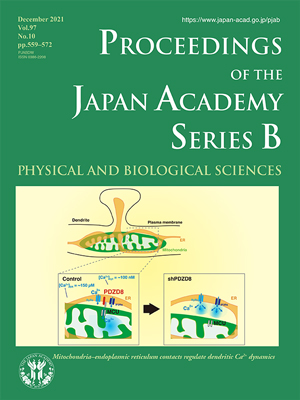About the Cover
Vol. 97 No. 10 (2021)
Mitochondria–endoplasmic reticulum contacts regulate dendritic Ca2+ dynamics
Calcium (Ca2+) is an intracellular messenger that propagates throughout the cell over millisecond timescales during neuronal transmission. The endoplasmic reticulum (ER) functions as an intracellular Ca2+ reservoir and regulates cytoplasmic Ca2+ levels upon neuronal excitation. It was long believed that the ER functioned as an isolated unit, but recently it has been shown that the ER forms contacts with other organelles such as mitochondria, endosomes, and lysosomes and acts cooperatively. Among these contacts, mitochondria–ER contact sites (MERCSs) are receiving a lot of attention because of the important biochemical reactions, such as Ca2+ exchange and lipid transport, which occur at this contact site. A tethering complex between the ER and mitochondria called the ER–mitochondria encounter structure (ERMES) complex was identified in budding yeast in 2009, whereas no clear functional ortholog for any ERMES protein has been identified in metazoans. Hirabayashi and colleagues have recently identified the ER-resident protein PDZD8 as a critical ER–mitochondria tethering protein in mammalian cells including neurons (featured in this issue as Tsuboi et al., pp. 559-572). Given that the ER and mitochondria exhibit a three-dimensionally intricate network, precise description of MERCSs, which are defined as a 10–30 nm distance between these organelles, necessitating three-dimensional (3D) rendering of electron microscopy (EM) images. Hirabayashi et al., utilized focused ion beam-serial EM to obtain hundreds of serial sectioning EM images and revealed that the percentage of MERCS area per mitochondria surface area was greatly reduced by PDZD8 knockdown in HeLa cells. Furthermore, high-speed dual-wavelength Ca2+ imaging using genetically encoded Ca2+ sensors specifically optimized for detecting Ca2+ ions in the ER or mitochondria showed that PDZD8-mediated MERCS formation in cortical neurons is essential for Ca2+ transfer from the ER to mitochondria upon synaptic stimulation. Lack of PDZD8 resulted in an increase in cytosolic Ca2+ evoked by neuronal excitation in the dendrites. This suggested that the extent of ER–mitochondria tethering controls cytosolic Ca2+ levels and thereby neuronal activity. This novel finding can provide new insights that MERCSs function as another regulatory layer in synaptic transmission and plasticity.
Yukiko Gotoh
Professor, Graduate School of Pharmaceutical Sciences,
The University of Tokyo




